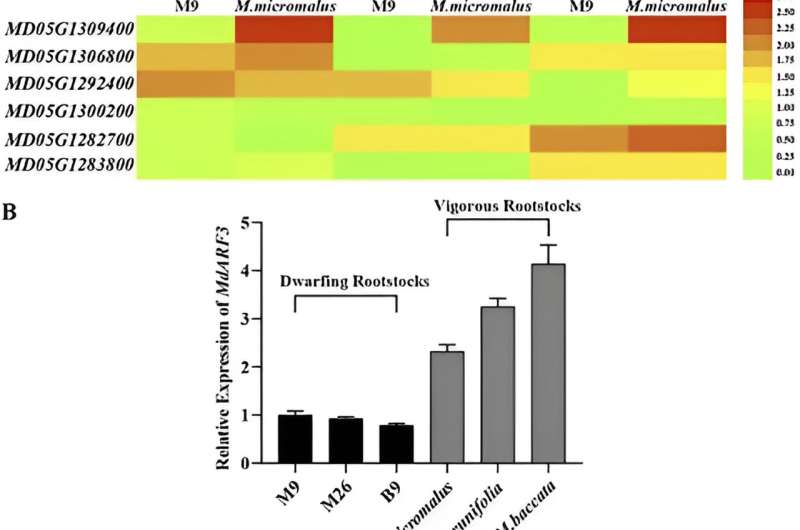This article has been reviewed according to Science X's editorial process and policies. Editors have highlighted the following attributes while ensuring the content's credibility:
fact-checked
peer-reviewed publication
proofread
From genes to growth: The science behind miniature apple trees

Apple farming heavily relies on dwarfing rootstocks like M9 for high-density planting and improved fruit quality. However, the exact mechanisms behind the dwarfing effect remain unclear. Previous studies have indicated that dwarfing traits are complex and involve multiple genetic factors. Based on these challenges, there is a need for an in-depth investigation to uncover the molecular basis of dwarfing in apple rootstocks.
A research team from China Agricultural University, led by Yi Wang and Zhenhai Han, published their findings in Horticulture Research on February 23, 2024. The study focuses on the gene MdARF3, located on the Dw1 loci, and its differential expression in dwarfing versus vigorous apple rootstocks. The discovery highlights the significant role of MdARF3 in regulating root elongation and plant height, offering new insights into apple rootstock breeding.
The study identified that the expression of MdARF3 in the root system of the M9 dwarfing rootstock is lower than in vigorous rootstocks due to a deletion in the promoter region. This deletion significantly impacts the transcriptional activity of MdARF3, leading to reduced root and plant growth. Through various experiments, including transgenic tobacco and apple models, the researchers demonstrated that higher MdARF3 expression promotes longer root systems and increased plant height.
Further molecular analyses revealed that the transcription factor MdWOX4-1 positively regulates MdARF3 by binding to its promoter. However, in the M9 genotype, the deletion of a WUSATAg element in the MdARF3 promoter prevents this interaction, leading to lower MdARF3 expression and subsequent dwarfing. This study provides a comprehensive understanding of the genetic and molecular interactions underlying the dwarfing trait in apple rootstocks.
Dr. Yi Wang, the senior researcher, stated, "Our findings shed light on the genetic mechanisms of apple dwarfing and open new avenues for molecular breeding. By targeting the MdARF3 pathway, we can develop improved dwarfing rootstocks that support efficient and sustainable apple production."
The discovery of the MdARF3 genetic switch offers significant implications for apple breeding programs. By manipulating the expression of MdARF3, breeders can develop new dwarfing rootstocks that combine the benefits of high-density planting, early fruit production, and superior fruit quality. This advancement not only enhances apple production efficiency but also supports the adoption of mechanized farming practices, reducing labor costs and increasing overall productivity.
More information: Jiahong Lv et al, MdARF3 switches the lateral root elongation to regulate dwarfing in apple plants, Horticulture Research (2024). DOI: 10.1093/hr/uhae051
Journal information: Horticulture Research
Provided by TranSpread




















